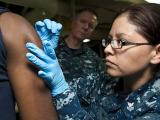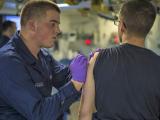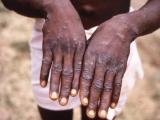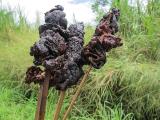Mar 26, 2002 (CIDRAP News) – A new, orally administered derivative of the antiviral drug cidofovir blocks the action of smallpox virus in laboratory tissue-culture cells and protects mice from the effects of cowpox virus, according to studies presented at a conference last week. Researchers say the results suggest that the drug may be an effective treatment for smallpox.
The new drug, called hexadecyloxypropyl-cidofovir (HDP-CDV), was 100 times more effective than cidofovir in slowing smallpox replication in human tissue culture, according to a news release from the University of California, San Diego (UCSD), where the compound was developed. In addition, the drug protected mice infected with a lethal dose of cowpox virus, a close relative of smallpox virus. The findings were presented Mar 20 at the 15th International Conference on Antiviral Research in Prague, Czech Republic.
The only proven protective measure against smallpox is vaccination. Cidofovir, an inhibitor of viral DNA polymerase, is currently used to treat retinal infections caused by cytomegalovirus. In a federal program to find a drug for smallpox, cidofovir was previously found to be effective against smallpox and related viruses in laboratory and animal studies, according to the UCSD statement. However, the drug must be given intravenously, which would limit its usefulness in dealing with a smallpox epidemic.
"Cidofovir's drawback is poor oral availability," said Karl Y. Hostetler, MD, UCSD professor of medicine and director of the Endocrine and Metabolism Clinic at the Veterans Affairs San Diego Healthcare System (VASDHS). "It can only be given intravenously. If you've got thousands of people exposed to smallpox, a drug that needs to be injected would be difficult to use widely." HDP-CDV was developed by Hostetler and James Beadle, PhD, a research professor at UCSD and VASDHS.
If further studies support the safety and effectiveness of HDP-CDV, it could be given in pill or capsule form for 5 to 14 days to prevent and treat smallpox in people exposed to the virus, Hostetler said. The drug must be tested further in animals and undergo safety trials in healthy people, the UCSD statement said.
Hostetler and Beadle have studied HDP-CDV in collaboration with groups headed by John Huggins, PhD, at the US Army Research Institute of Infectious Diseases at Fort Detrick, Md., and Earl Kern, PhD, at the University of Alabama, Birmingham. At the conference, Huggins's group presented data on the performance of the drug in tissue culture and in mice, according to UCSD officials.
In one tissue-culture study, HDP-CDV produced the same effect against smallpox, monkeypox, cowpox, and vaccinia as unmodified cidofovir did, even though the HDP-CDV was given at 100- to 1,000-fold lower concentrations, according to an abstract supplied by UCSD.
In another study, mice were infected with a normally lethal dose of cowpox virus, and forced feeding of an HDP-CDV solution was begun the same day, according to an abstract. Several groups of 10 mice were treated with varying dosages of the drug for 5 days. At the lowest dose, 0.63 mg/kg/day, half of the mice survived, and all mice treated with 5 or 10 mg/kg/day survived. Among mice treated orally with 10 or 20 mg/kg/day of unmodified cidofovir, 9 out of 10 died. To test for drug toxicity, uninfected mice also were treated with various dosages of HDP-CDV, and all survived.
The Huggins group also found that virus in the lungs of infected animals dropped to nearly undetectable levels after oral administration of HDP-CDV, but not after intravenous treatment with comparable levels of cidofovir, according to the UCSD statement.
In other research presented at the conference, Kern's group found HDP-CDV to be active in tissue cultures against infections caused by cytomegalovirus, herpes virus, varicella zoster virus, and Epstein-Barr virus, UCSD officials said.
UCSD officials said Hostetler's research was supported by grants from the Department of Defense, the National Institute on Allergy and Infectious Diseases, the National Eye Institute, and VASDHS.
See also:
UCSD news release describing the findings
http://ucsdnews.ucsd.edu/newsrel/health/smallpox.htm



















